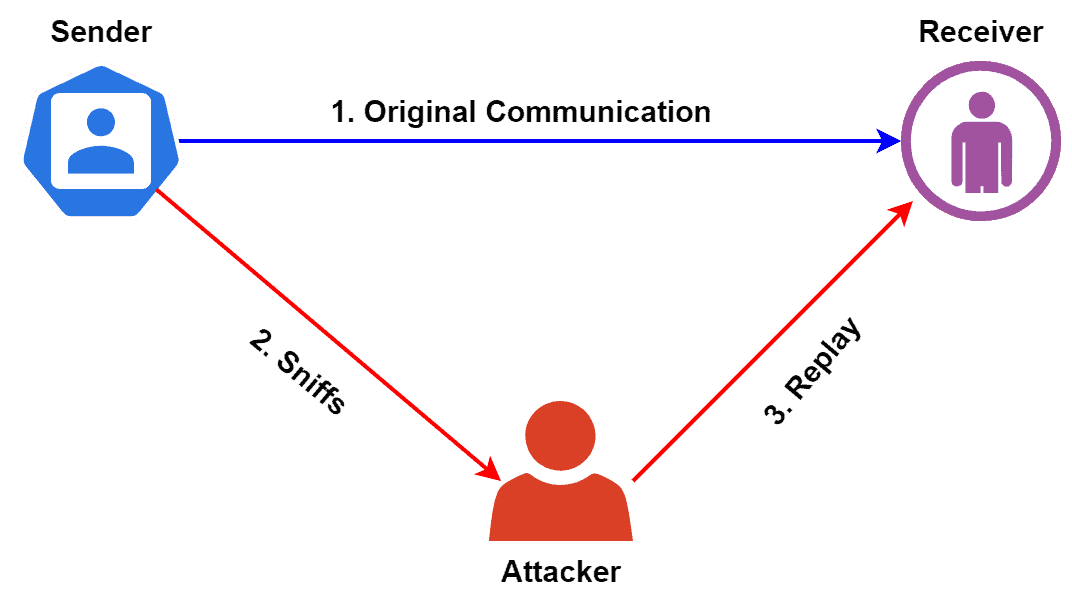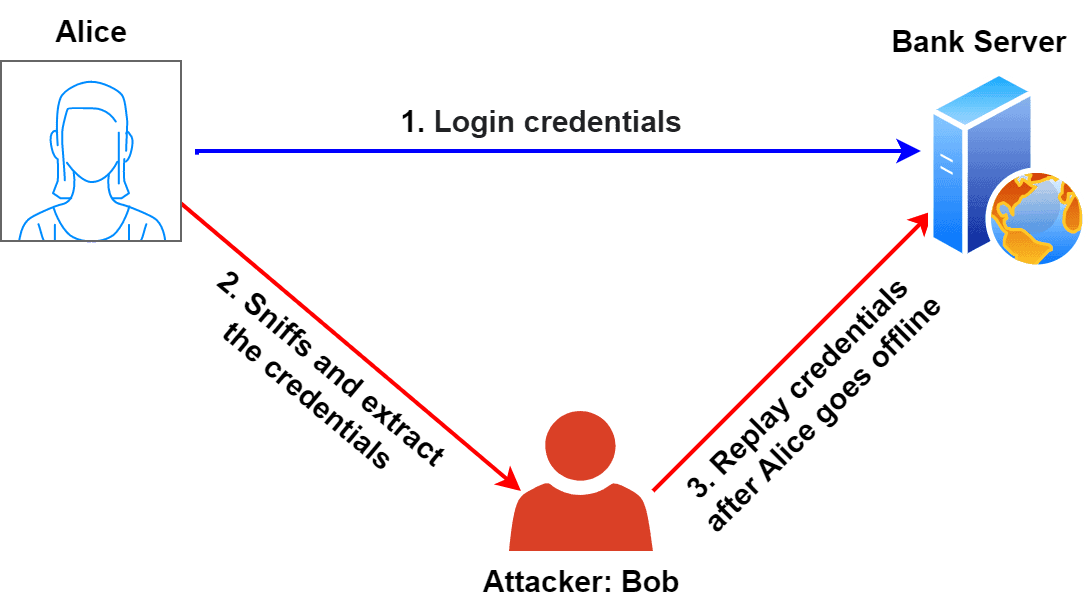Learn through the super-clean Baeldung Pro experience:
>> Membership and Baeldung Pro.
No ads, dark-mode and 6 months free of IntelliJ Idea Ultimate to start with.
Last updated: June 29, 2024
In this tutorial, we’ll discuss the fundamental idea behind replay attacks with a practical example.
Finally, we’ll present some techniques to detect and prevent replay attacks in a network.
A replay attack is a type of network attack in which an attacker captures a valid network transmission and then retransmit it later. The main objective is to trick the system into accepting the retransmission of the data as a legitimate one. Additionally, replay attacks are hazardous because it’s challenging to detect. Furthermore, it can be successful even if the original transmission was encrypted.
An attacker can lunch a replay attack to gain unauthorized access to systems or networks. Furthermore, a replay attack can disrupt the regular operation of a system by inundating it with repeated requests. An attacker can plan to carry out this attack by intercepting and retransmitting data packets over a network. Additionally, a successful replay attack can be performed by replaying recorded audio or video transmissions.
Let’s take a look at the simple diagram which depicts how a simple replay attack works:

The sequence in which the events occur is vital in a replay attack. We can lunch a replay attack by following three simple steps. The first step is to wait for the data transmission to begin. The attacker then tries to sniff into the communication channel and extract the data.
As soon as the attacker gets the data, it might modify or change it based on the objective and retransmit it to the receiver. The receiver receives the tempered data but treats it as the original data.
There’re different types of replay attacks in networking. We’ll discuss four types of most widely used replay attacks: network, wireless, session, and HTTP replay attacks.
In network replay attacks, the attacker intercepts network traffic and then resends it at a later time. This can be done using tools like Wireshark or tcpdump. Similarly, in the case of wireless replay attacks, the attacker intercepts wireless communications and then resends them.
Furthermore, the attacker intercepts a session between two parties in case of session replay attacks. The attacker captures HTTP requests and responses to launch HTTP replay attacks.
Let’s take a look at the summary of different types of replay attacks in networking:
| Types of Replay Attack | Attack Vector |
|---|---|
| Network | Network traffic |
| Wireless | Wireless communications |
| Session | Sessions between two parties |
| HTTP | HTTP requests and responses |
Let’s discuss a practical example of a replay attack in the banking scenario:

Imagine that Alice is trying to log into her online banking account using a secure web connection. When she enters her login credentials and clicks the submit button, the login request is sent over the internet to the bank’s server.
An attacker, Bob, is monitoring the network and captures the login request as it is transmitted. Bob then waits until Alice has logged out of her account and retransmits the captured login request to the bank’s server. Because the login request is valid, the server accepts it and grants Bob access to Alice’s account.
In this scenario, Bob can gain unauthorized access to Alice’s account by replaying a captured login request. However, Alice can prevent a replay attack using a secure communication channel that includes a timestamp or a nonce.
Now we know the concept behind the replay attack. Let’s discuss some techniques that we can use to prevent replay attacks. Here, we’ll discuss five techniques: the use of secure communication protocols, the use of message authentication codes, the utilization of timestamps, the utilization of nonces, and the employment of challenge-response protocols.
By using secure communication techniques, we can prevent replay attacks in a network. Some popular secure communication protocols are SSL, TLS, and IPSec. Furthermore, these protocols typically use timestamps, nonces, and other techniques to ensure the authenticity and correctness of transmitted data.
Another popular technique is to use message authentication codes (MACs). MACs are cryptographic checksums included in transmitted data to ensure authenticity and integrity. Furthermore, MACs can prevent replay attacks by having a timestamp or other value that changes with each transmission, making it difficult for attackers to reuse a captured transmission.
Including a timestamp in the transmitted data can help to prevent replay attacks by ensuring that the data is only considered valid within a specific time frame. Additionally, we can also use nonce while transmitting data in a network.
A nonce is a randomly generated value that is included in the transmitted data and can be used to prevent replay attacks. Because we randomly generate the nonce, it’s unlikely that an attacker will be able to guess or recreate it correctly.
Finally, the use of challenge-response protocols can efficiently prevent replay attacks. Challenge-response protocols require the receiver to respond to a transmitted message with a unique response derived from the original message. This can make it difficult for an attacker to replay the original message because the response won’t be valid.
Additionally, it’s important to update regularly and patch systems and devices to protect against known vulnerabilities that could be exploited in a replay attack. Furthermore, it’s also a good idea to use firewalls and other security measures to protect against network-based attacks.
In this tutorial, we discussed the fundamental idea behind replay attacks with a practical example. Finally, we presented some techniques to detect and prevent replay attacks.